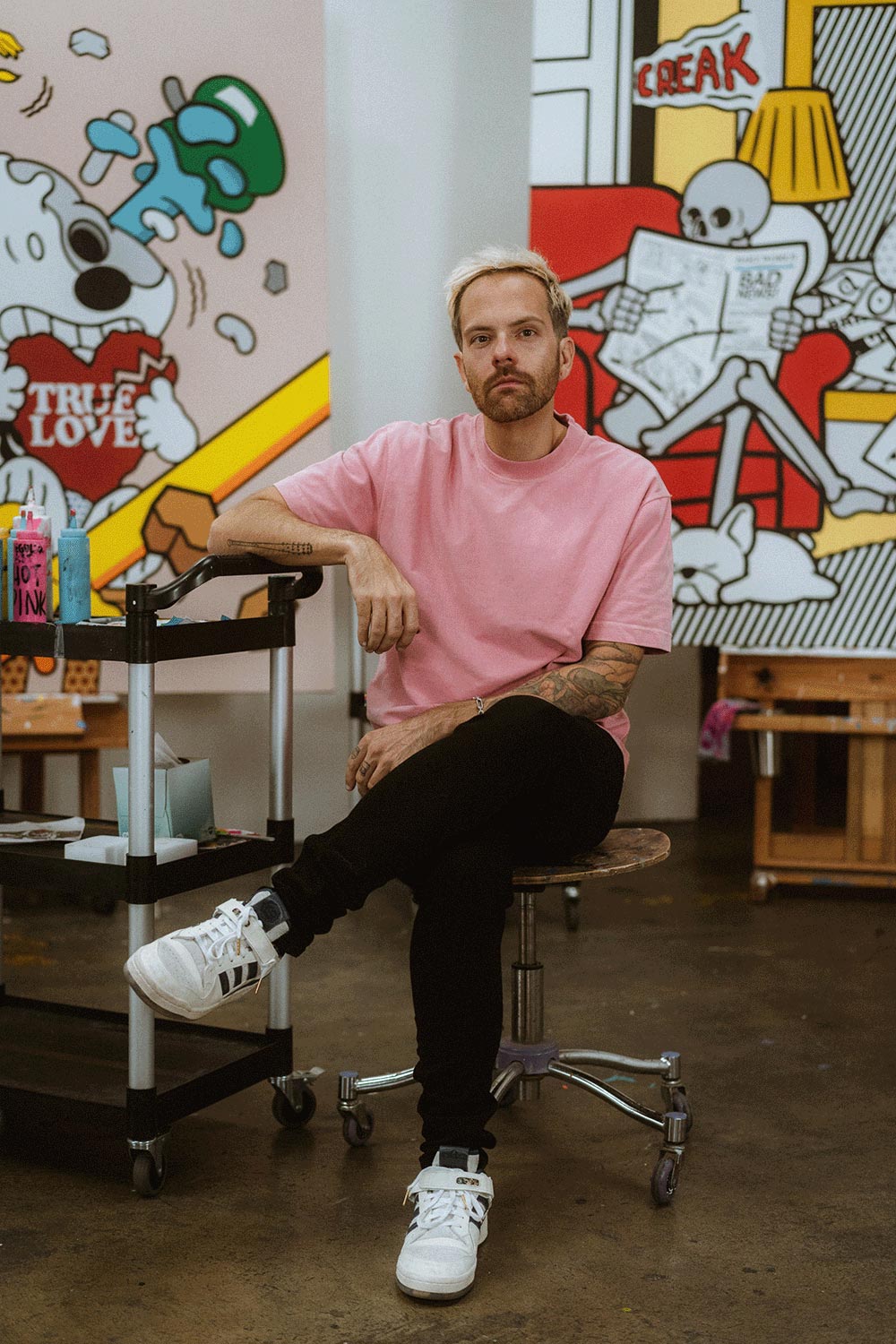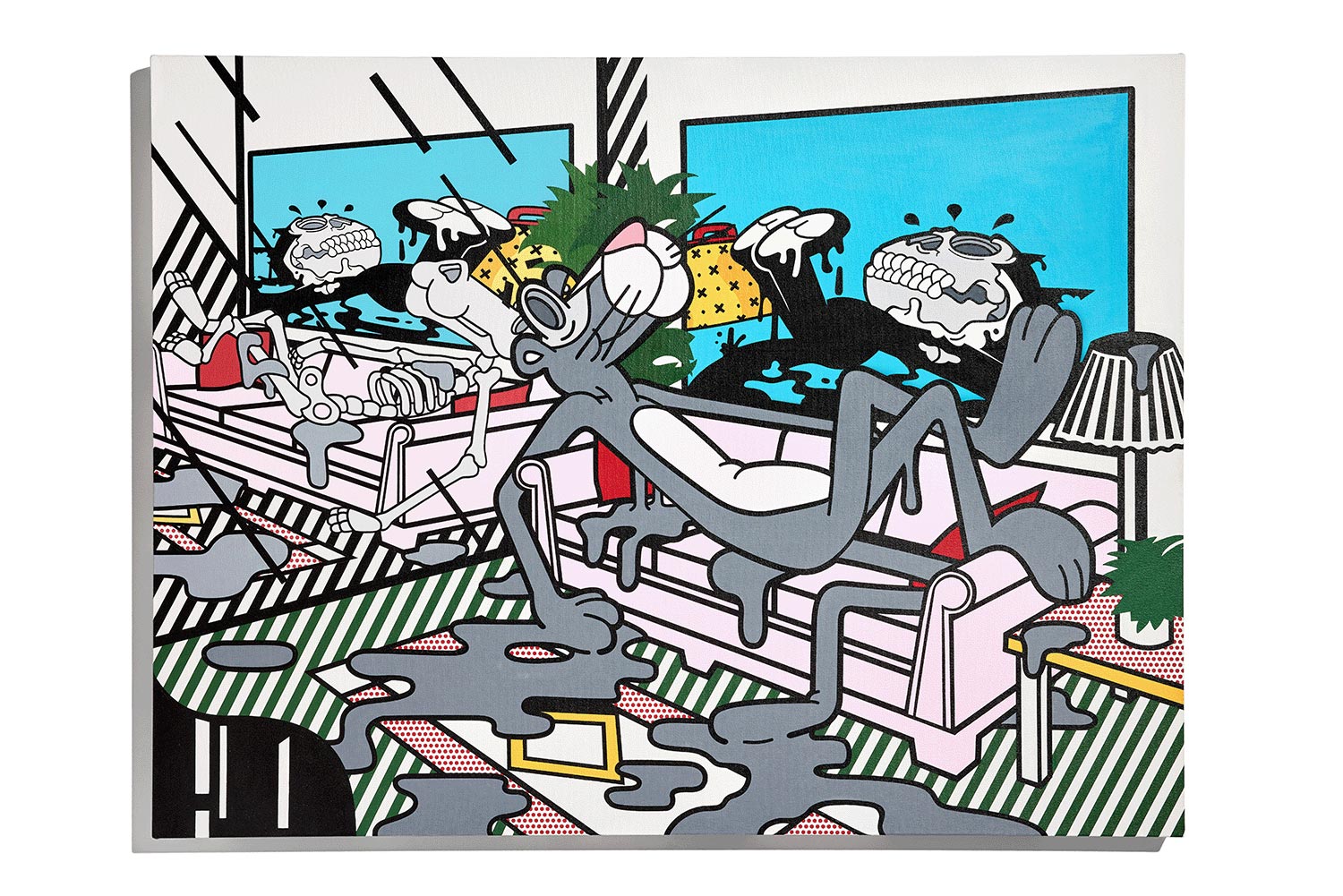A self-described “Deconstructive Pop Artist”, Matt Gondek’s work celebrates rebellion and destruction. With a visceral pop colour palette and a disarmingly playful tone, he tears down cartoon idols, akin to slaughtering modern day gods. Born in 1982, his creative voice is rooted in the Nineties — a conduit of his generation’s potentially pointless search for meaning and purpose amidst a cruel life in a flawed world. His shows include solo exhibitions in New York, Paris, Bangkok, and Hong Kong.
Q > What inspired you to start exploring the playful deconstruction of iconic characters in your art?
A > Thank you for the interview! About 15 years ago, I was working on a freelance illustration job that had me drawing Mickey Mouse in over 100 poses. As the job went on and on, I started just drawing funny and weird ones out of boredom — one of those being his head exploding. Once the job was done, that drawing, along with all of the others, went in a drawer and was forgotten about.
About a year later, I was sort of lost with where my art was going (up to that point I was only drawing digitally on the computer) and decided to try to paint. Not knowing what to make for my first painting, I opened up that drawer of old drawings and randomly grabbed the one of Mickey’s head exploding.
I really enjoyed the tactile nature of creating physical work and the rest is history.

Matt Gondek. Photography by KT1992
Q > Tell us about your creative process when transforming such familiar characters into fractured, dynamic compositions?
A > It normally starts with just an idea that I get while working on other things, or out for a walk or driving. I begin by gathering a ton of reference images, both from the internet, the Downtown Los Angeles library, and old comics. Then, I start sketching everything out digitally until I have a pretty good representation of what I want the physical painting to look like.
After that, I started working on canvas painting. Over the years, I’ve created my own library of custom paint colours through experimentation. Colours like Pink Cocaine, 1000 Wott Neon Yellow (purposely misspelt), and Maliblu.
Q > Going beyond the playful aesthetics, is there a deeper message or narrative you intend to convey through your compositions?
A > When you consider classical artwork in museums, a significant portion of it revolves around themes of royalty and religion. During the times when those works were created, monarchy and the church were daily fixtures in popular culture. However, fast forward to 2023, and these influences have waned. Instead, we find icons like Mickey Mouse and Bart Simpson taking their place. In a way, these characters can be seen as our modern-day gods. Given my upbringing with a punk mindset focused on anti-conformity, my work aims to deconstruct those in power, which now includes these characters.
I call my style “Deconstructive Pop Art”.
Q > How has your style evolved since you began experimenting with this unconventional approach, and where do you see it heading in the future?
A > When I started painting around 11 years ago, I had no idea what I was doing. A lot of the earlier work is really simple in nature: one-colour backgrounds, one character, etc. As I’ve become a more competent and confident artist, the arrangements have become much more intricate and chaotic. So much so that my more recent work spans across several smaller canvases as opposed to just one big canvas. I wanted to push the level of deconstruction even further by tearing apart the painting itself.
Q > Have you faced any unexpected reactions or controversies regarding your reinterpretation of beloved characters, and how do you navigate these responses?
A > My work is easy to love, as it features a lot of references that almost anyone can identify with. This, in itself, is a ladder that allowed me to find admirers quickly. However, at what point does using pop culture references become a crutch? Like most artists, you always want to push yourself and grow, and mentally, my biggest hurdle is the little voice in the back of my head questioning if I’d be successful if I didn’t use famous cartoon characters in my narratives.
Despite the bouts of self-doubt, I’ve been creating this type of work since I was a baby. Even if sometimes I doubt myself, I’m not sure what else I’d be doing. It’s all I’ve ever done!

Oppulence Gray. Photography by Gondek Studio
Q > Your work often combines whimsy with depth. How do you strike a balance between playful reinterpretation and retaining the essence of the characters you depict?
A > I only use characters I’m familiar with. When you understand your subject matter, you know what type of things and situations they’d find themselves in. One of the main reasons I stopped doing commissions for so many years was that I was being asked to create work using subject matter I was unfamiliar with. It made me uncomfortable.
Q > If you could give your 16-year-old self a message (or advice) what would you tell them?
A > Honestly, I don’t know. Everything I’ve done has led me to today, the good and the bad. I’d just tell them to keep their head up, as life gets way better.
Q > What do you do when you’re stuck, or not feeling creative?
A > I get back to work. I treat my art practice like any other small business. You can’t hit a home run every time, but you do need to show up for every game.
Q > Your favourite ritual?
A > Every night for the last few months, I crawl into bed with my girlfriend, and we watch an episode of King of the Hill until we fall asleep.
On a more businessy/artistic side, for as long as I can remember, I’ve always carried around a little black day planner. As a Virgo, the absolute thrill of scratching off something on that day’s to-do list makes me feel so good.
Q > Predictions: what is something you strongly believe is going to come to pass?
A > I have a podcast where I interview artists. Recently, I had the artist Ron English on, and something he said has been haunting me for the last few months. He mentioned that “in 400 years from now, the only artists that will be remembered from this time period are Andy Warhol and Picasso”. Now, whether or not you believe him, it’s incredibly hard to create anything that will be remembered decades from now. This idea has been eating away at me, making me question, “Why even try?” And I think the answer is that you should try to make yourself happy, not work yourself to death, and enrich the lives of those around you. Because everything else will come to pass 🙂
